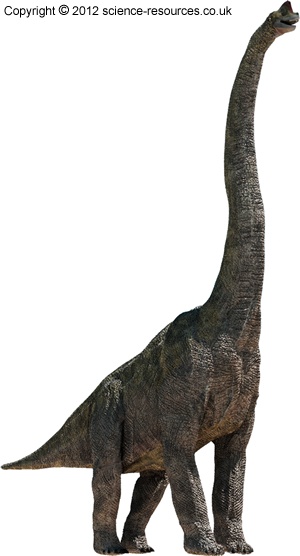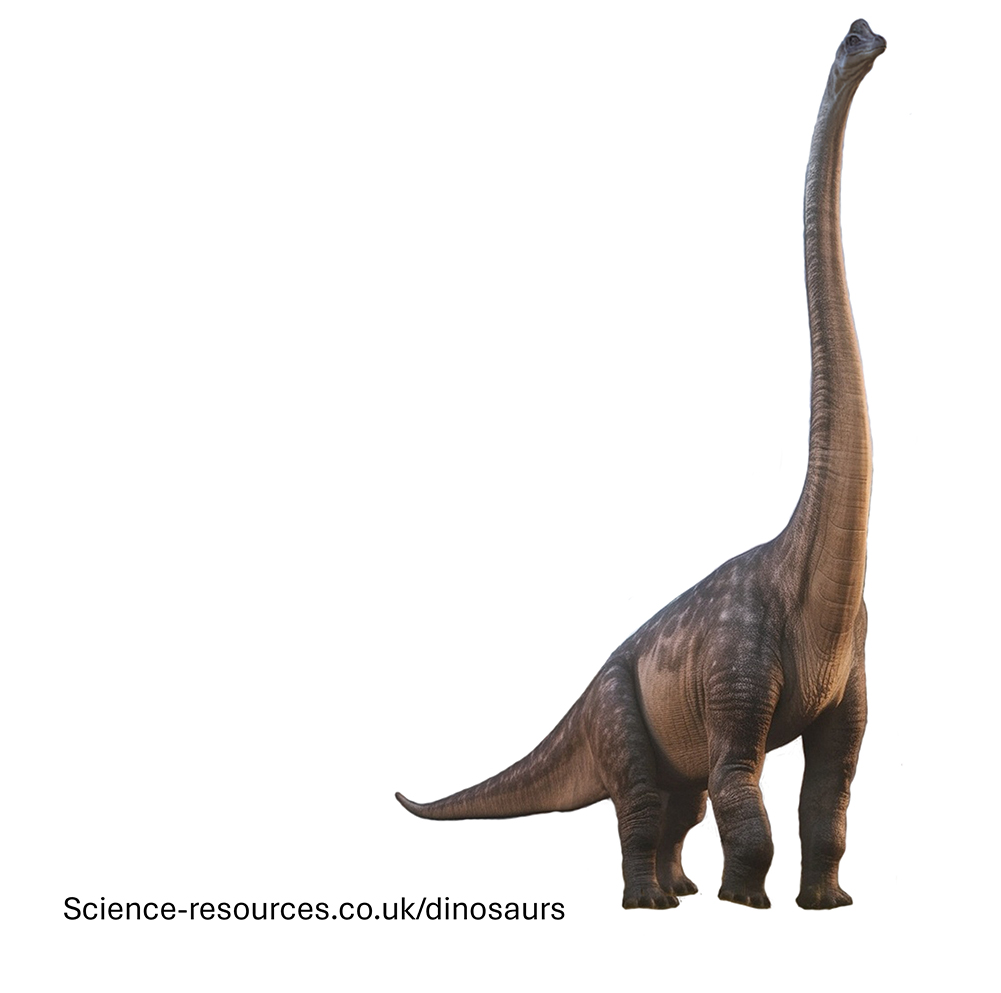i-How: How big was Brachiosaurus (and other amazing facts)
Length: Brachiosaurus could reach up to 25 metres (82 feet) long. Height: At the tallest point, its head could reach approximately 12–13 metres (39–43 feet) above the ground. Weight: Estimates suggest Brachiosaurus weighed between 28,000 to 58,000 kg (28 to 58 tonnes). Brachiosaurus was a herbivore, feeding primarily on high-growing vegetation. Its long neck allowed it to browse from the tops of trees that other dinosaurs could not reach. It likely ate conifers, ginkgos, and cycads, stripping leaves with its peg-like teeth and possibly swallowing plant material whole. Most films, including Jurassic Park, depict Brachiosaurus as an enormous, gentle, giraffe-like dinosaur. While its general size and long neck are accurate, some depictions exaggerate its posture, showing it rearing up or vocalising in ways unsupported by fossil evidence. Scientific findings suggest it held its neck more vertically than horizontally, but not in the highly upright swan-like pose often seen on screen. Skin impressions indicate it had rough, scaly skin, not the smooth hides sometimes shown in popular media. No, Brachiosaurus could not stand on its hind legs for extended periods because it was front-heavy, with longer front legs than hind legs, which made it unstable. While it may have been able to rear up briefly for specific purposes like mating, it was not a regular posture and it was likely dangerous for the dinosaur. Neck: Exceptionally long, accounting for about half its body length, allowing it to reach high foliage. Front legs: Much longer than its hind legs, giving its body a sloped appearance from back to front. Skull: Small relative to body size, with nostrils located on top of its head. Tail: Long and muscular, providing balance. Teeth: Spoon-shaped and suited for stripping leaves. Modern Brachiosaurus reconstruction (Image source: https://science-resources.co.uk/KS2/Dinosaurs/Brachiosaurus.html) Unique Features:
Dinosaurs
Contents:
How big was Brachiosaurus?
How did Brachiosaurus feed?
How Accurate is the Jurassic Park Brachiosaurus?
 Jurassic Park / Jurassic World Brachiosaurus (Image source: https://science-resources.co.uk/KS2/Dinosaurs/Brachiosaurus.html)
Jurassic Park / Jurassic World Brachiosaurus (Image source: https://science-resources.co.uk/KS2/Dinosaurs/Brachiosaurus.html)Did Brachiosaurus stand on its hind legs?
 Jurassic Park Brachiosaurus standing on two legs (Image source: https://science-resources.co.uk/KS2/Dinosaurs/Brachiosaurus.html)
Jurassic Park Brachiosaurus standing on two legs (Image source: https://science-resources.co.uk/KS2/Dinosaurs/Brachiosaurus.html)How did Brachiosaurus look?
How unique was Brachiosaurus?
|
Brachiosaurus image courtesy of science-resources.co.uk |
Brachiosaurus FactsPronounced: BRACK-ee-oh-SAW-ru Length: 82 feet (25 m) |
Brachiosaurus size image courtesy of science-resources.co.uk
Speed: Brachiosaurus was a slow-moving dinosaur due to its size. Estimates suggest it could walk at speeds of 5–10 miles per hour (8–16 km/h). Its massive weight and column-like legs meant it was built for steady, not rapid, movement. Intelligence: Like most sauropods, Brachiosaurus had a relatively small brain compared to its body size. Its intelligence was likely limited, focused on basic survival instincts such as feeding, migration, and avoiding predators. Fossil: The most famous Brachiosaurus specimen, discovered in the early 20th century in Colorado, is known as the “type specimen.” It consists of significant portions of the vertebral column, limb bones, and a few ribs, but no complete skull. Subsequent finds, such as those in Africa, have helped fill in some anatomical details. Brachiosaurus was a member of the Brachiosauridae family, a group of sauropod dinosaurs known for their long necks and forelimbs. It is closely related to other giant sauropods like Giraffatitan and Lusotitan. Brachiosaurus was a quadruped, walking on all four legs. Its longer front legs gave it an upright posture, allowing it to access high vegetation. Tracks suggest it moved in herds, traversing floodplains and open woodlands in search of food. Its enormous size deterred most predators, while its long neck enabled it to feed on foliage out of reach for other herbivores. Its high browsing niche reduced competition for food. Column-like legs and a massive body allowed it to travel long distances in search of vegetation. Brachiosaurus was a sauropod, part of a larger group of long-necked, plant-eating dinosaurs. It shared common ancestry with other sauropods but was distinct for its unique limb proportions and browsing habits. Early reconstructions often depicted Brachiosaurus as a swamp-dweller with a highly elevated, swan-like neck. Modern research supports a more terrestrial lifestyle, with a straighter neck posture and robust, heavily built limbs. Recent studies and fossil finds have led to reclassifications and clearer distinctions from similar genera, such as Giraffatitan. Q1: How complete is the most famous Brachiosaurus fossil? A1: The type specimen discovered in Colorado is the most complete, including significant parts of the vertebrae and limbs, but lacks a complete skull. Q2: How does Brachiosaurus fit into the dinosaur family tree? A2: Brachiosaurus belongs to the Brachiosauridae family, closely related to other long-necked sauropods. Q3: How did Brachiosaurus move? A3: Brachiosaurus was a quadruped, walking on all four legs with a characteristically upright posture due to its longer front legs. Q4: How did Brachiosaurus’s physical features affect its survival? A4: Key features such as its long neck and immense size enabled Brachiosaurus to feed on high foliage and avoid most predators. Q5: What unique features did Brachiosaurus possess? A5: Unique among sauropods for its long front legs, upright stance, and nostrils positioned atop its head. Q6: How was Brachiosaurus related to other dinosaurs? A6: Brachiosaurus was a sauropod, related to other gigantic, long-necked herbivores but unique in its body proportions. Q7: How has the appearance of Brachiosaurus changed over time? A7: Earlier depictions as swamp dwellers have given way to modern reconstructions as large terrestrial browsers. Q8: What insights do Brachiosaurus fossils provide? A8: Fossils reveal its huge size, limb structure, and adaptations for high browsing, contributing to our understanding of sauropod diversity. Q9: What were the main adaptations of Brachiosaurus that made it a successful herbivore? A9: Its height, long neck, and specialised teeth enabled efficient feeding from tall trees, while immense size provided defence. Q10: How has public perception of Brachiosaurus evolved? A10: Public perception has shifted from viewing Brachiosaurus as a swamp-dwelling giant to recognising it as a towering, terrestrial browser. How fast could Brachiosaurus move?
How smart was Brachiosaurus?
How complete is the most famous Brachiosaurus fossil?
How does Brachiosaurus fit into the Dinosaur family tree?
How did Brachiosaurus move?
How did Brachiosaurus's features affect its survival?
How was Brachiosaurus related to other Dinosaurs?
How has the Appearance of Brachiosaurus changed over time?
Frequently Asked Questions About Brachiosaurus
You may also be interested in
Tags: How big was Brachiosaurus; Brachiosaurus; How fast was Brachiosaurus, Brachiosaurus size, how tall was Brachiosaurus, Brachiosaurus name mean, Brachiosaurus height, height of Brachiosaurus, Jurassic Park Brachiosaurus, Jurassic World Brachiosaurus, how big were Dinosaurs


